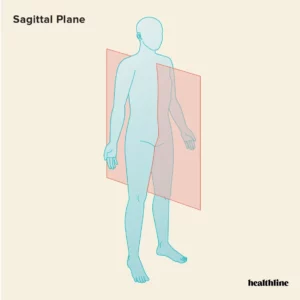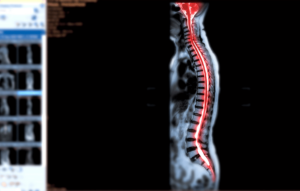When we hit the gym, many of us often gravitate toward the big, familiar lifts – squats, deadlifts, and bench presses – maybe some pushdowns and shoulder presses. These exercises are the backbone of traditional strength training, and for good reason: they build serious muscle and power. But there’s a catch. While these movements excel at developing strength, they all occur in a single plane of motion: the sagittal plane.
The sagittal plane divides the body into left and right halves and governs forward and backward movements. It’s the reason why you can squat down to pick something up or drive up for a powerful deadlift. However, by focusing solely on the sagittal plane, as so many do, you’re missing out on a crucial aspect of your athleticism – multi-directional movement. This oversight can lead to muscle imbalances, poor posture, and a higher risk of injury.
In this blog, we’ll take a look at why training exclusively in the sagittal plane limits your potential and how incorporating movements across all planes of motion can elevate your performance. Whether you’re aiming to enhance your athletic abilities, prevent injuries, or achieve long-term fitness goals, you’ve gotta train beyond the sagittal plane.
Understanding the Sagittal Plane
To fully appreciate why it’s essential to train beyond the sagittal plane, we first need to understand what it is. The sagittal plane is an anatomical term that divides the body into left and right halves. It’s the plane responsible for movements like flexion and extension – think of bending and straightening your arm or leg, or the motion of squats and lunges.

These movements are foundational in many sports and exercise routines because they help build strength and power in a straightforward, linear manner. Whether you’re sprinting down the track, driving a barbell up in a deadlift, or powering through a set of push-ups, you’re primarily moving within the sagittal plane.
However, while the sagittal plane is crucial for these powerful, linear actions, it only represents one of many dimensions of movement. Our bodies are designed to move in three-dimensional space, and sticking exclusively to sagittal plane exercises means you’re neglecting the other planes of natural motion – the frontal and transverse planes. This imbalance can set you up for a range of problems, from reduced athletic performance to a higher risk of injury.
In the sections that follow, we’ll explore these other planes of motion and explain why they are just as important – if not more so – for achieving well-rounded fitness and athleticism.
The Hidden Dangers of Sagittal Plane Dominance
Relying too heavily on sagittal plane exercises might seem harmless – after all, these movements are the cornerstone of many fitness routines. However, this one-dimensional focus can have significant drawbacks that often go unnoticed until it’s too late.
Imbalance and Injury Risk
When you only train in the sagittal plane, you’re more likely to develop muscle imbalances. For example, if your workout routine is dominated by squats, deadlifts, and push-ups, you’re primarily strengthening the muscles responsible for forward and backward motion. Meanwhile, the muscles that control side-to-side movements or rotational stability might be underdeveloped. This imbalance can make you more prone to injuries, particularly in sports that require quick changes in direction, lateral movements, or rotational force – think basketball, soccer, or tennis. 
Postural Issues
Another common issue with sagittal plane dominance is poor posture. Overemphasizing exercises like squats and deadlifts can lead to a forward head posture, rounded shoulders, or even excessive arching of the lower back. These postural problems don’t just affect your appearance; they can also hinder your athletic performance and increase the likelihood of chronic pain or injury.
Aging and Longevity Concerns
As we age, strength imbalances can become even more problematic. A strong emphasis on sagittal plane movements without attention to other planes of motion may contribute to joint degradation and a higher incidence of surgeries, such as knee and hip replacements. By the time these issues surface, the damage may already be done, making recovery more challenging and long-term fitness goals harder to achieve.
The Importance of Multi-Plane Training
While the sagittal plane is essential for building foundational strength, it’s only one piece of the puzzle. To achieve true athleticism and maintain long-term physical health, it’s crucial to incorporate exercises that engage all three planes of motion: sagittal, frontal, and transverse.
Frontal Plane Movements
The frontal plane divides the body into front and back halves, and it governs side-to-side movements. Think about exercises like lateral lunges, side shuffles, or lateral raises – these are all frontal plane movements. By incorporating these exercises into your routine, you’ll target muscles that are often neglected in sagittal plane-focused workouts, such as the abductors and adductors in your legs, and the lateral muscles in your shoulders and core.
Training in the frontal plane not only helps to balance muscle development but also improves your stability and coordination. These benefits are especially valuable in sports that require lateral movements, such as soccer, basketball, and skiing. Without training these muscles, you risk being less agile and more prone to injury when performing side-to-side motions.
Transverse Plane Movements
The transverse plane divides the body into upper and lower halves and is responsible for rotational movements. This plane is often the most neglected in traditional strength training routines, yet it’s incredibly important for overall functional fitness. Exercises like Russian twists, wood chops, and rotational lunges are great for engaging the transverse plane.
Rotational movements are key to many athletic activities, from swinging a bat or golf club to throwing a punch or changing direction quickly on the field. Training the muscles involved in these movements enhances your rotational power and stability, making you a significantly more well-rounded athlete. Additionally, improving your ability to rotate effectively can protect your spine and hips from injury, as it encourages better movement patterns and reduces strain on these areas.
Holistic Strength and Mobility
By incorporating movements from all three planes into your training, you’ll not only improve your strength but also enhance your mobility, coordination, and overall performance as an athlete. This multi-plane approach ensures that you’re preparing your body for the varied and dynamic challenges of real-life activities, whether on the field, the court, or just in everyday life.
Integrating Multi-Plane Movements into Your Routine
Now that you understand the importance of training in all three planes of motion, the next step is to start incorporating these movements into your workout routine.
Assessing Your Current Routine
Start by taking a close look at your current workout regimen. How many of your exercises are solely sagittal plane-focused? If you’re like most people, you’ll find that the majority of your routine involves movements that are linear – think squats, deadlifts, bench presses, and rows. Identifying this imbalance is the first step toward a more holistic training approach.
Incorporating Frontal Plane Exercises
To balance your routine, begin adding frontal plane exercises that emphasize lateral movement. For example:
-
- Lateral Lunges: Great for working the inner and outer thighs while improving hip mobility.
-
- Side Shuffles: Excellent for developing agility and coordination, particularly useful in sports like basketball or soccer.
-
- Lateral Band Walks: These strengthen the gluteus medius, an often-overlooked muscle that plays a key role in stabilizing the hips.
Adding Transverse Plane Movements
Next, introduce transverse plane exercises that focus on rotational strength and stability. Consider including:
-
- Russian Twists: A core-strengthening exercise that enhances your ability to rotate the torso effectively.
-
- Wood Chops: Mimics the action of chopping wood and engages the entire body in a dynamic, rotational movement.
-
- Rotational Lunges: Combines the benefits of lunges with a rotational twist, improving balance and coordination.

Programming for Balance
To ensure a balanced approach, aim to include exercises from all three planes in every workout session. This doesn’t mean you need to overhaul your entire routine – start by adding one or two frontal and transverse plane exercises to your existing workouts. Over time, you can increase the variety and intensity of these movements.
For example, if you’re doing a leg day focused on squats and deadlifts, consider finishing your workout with lateral lunges and rotational lunges. On upper body days, supplement your bench presses and rows with side planks or Russian twists.
Progression and Adaptation
As with any new training method, it’s important to progress gradually. Start with bodyweight exercises to master the movement patterns before adding any resistance. Pay attention to how your body responds, and don’t rush the process. Multi-plane training will likely be challenging at first, but with consistency, you’ll notice significant improvements in your strength, mobility, and overall athletic performance.
Final Thoughts
Training in the sagittal plane has its merits, but it’s only a fraction of what your body is capable of. By expanding your routine to include exercises from the frontal and transverse planes, you’re not just working different muscles – you’re building a more resilient, balanced, and versatile body that is more equipped to move through a world that requires us to be dynamic. Whether you’re an athlete aiming to enhance your performance or someone who wants to stay fit and injury-free, multi-plane training is essential for achieving well-rounded fitness.
As you start to integrate these new movements into your routine, you’ll slowly but surely notice improvements in your agility, coordination, and overall strength. More importantly, you’ll be better prepared for the unpredictable nature of both sports and everyday life. So, step out of the sagittal plane, challenge your body in new ways, and take your training – and your health – to the next level.
Remember, true fitness isn’t just about moving more weight; it’s about moving weight better. By training beyond the sagittal plane, you’re investing in a stronger, more functional body that can perform at its best in any situation.







